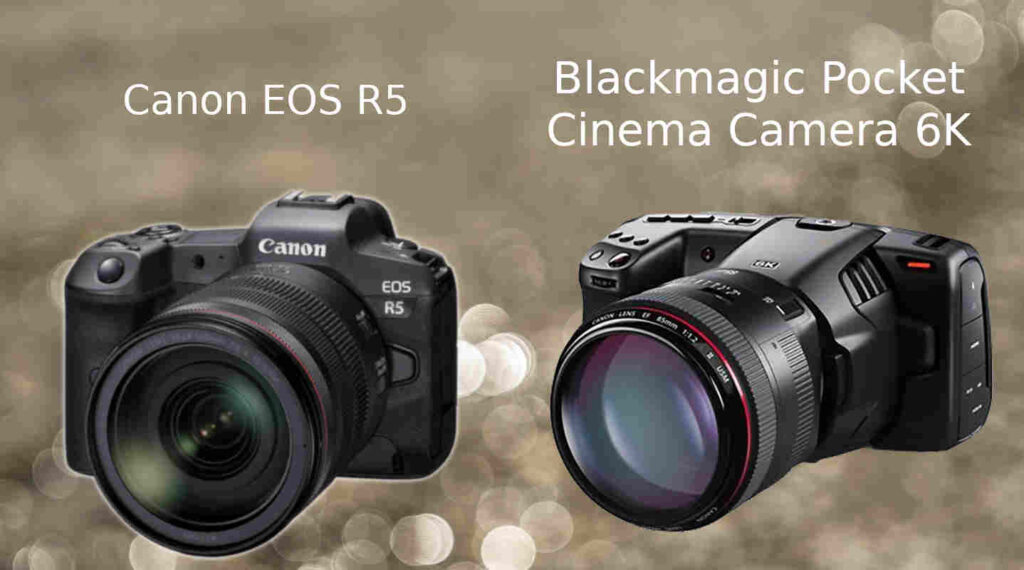Prices and stock may differ due to devaluation of Pkr and Global chip shortage, however we will confirm the current prices and stock on order confirmation call.


Canon EOS R5 shattered the hybrid camera market by introducing 8K RAW video support into the full-frame mirrorless camera segment. On the other hand, the Blackmagic Design Pocket Cinema Camera (BMPCC) 6K is one of the best portable Super 35mm cameras. While the BMPCC 6K only aims at producing cinematic videos, the mighty Canon R5 is a hybrid 8K camera packed with high resolution. Let’s compare Canon R5 vs BMPCC 6K.
Canon R5 vs BMPCC 6K | Price Comparison
the Canon EOS R5 costs a lot more than the Blackmagic BMPCC 6K camera. The price difference seems justifiable as EOS R5 offers features that were once exclusive to high-end cinema cameras.
BMPCC 6K boasts a Super 35 (23.1 x 12.99 mm), the standard 35mm film equivalent, CMOS sensor whereas the Canon EOS R5 is powered by a full-frame CMOS sensor. The sensor resolution of R5 (8192 x 5464) exceeds the sensor resolution of Blackmagic BMPCC 6K (6144 x 3456).
Although Canon R5 can record 8K RAW videos, note that it can only reach a frame rate of up to 30fps with that resolution. At 4K, it can shoot 10-bit 4:2:2 videos at up to 120 fps and that too internally, that’s pretty impressive. BMPCC 6K on the other hand is capable of recording 6K RAW videos up to 60 fps. So at 6K resolution, you’re getting better frame rates with Blackmagic BMPCC 6K than Canon EOS R5. But don’t forget the difference in sensor size, format, and image processor.
Canon EOS R5 features Canon RF lens mount whereas BMPCC 6K comes with Canon EF lens mount. In effect, BMPCC 6K has a wide range of lenses to choose from compared to the R5. But the lens range for Canon full-frame mirrorless cameras is also increasing rapidly.
BMPCC 6K boasts a Blackmagic RAW format, whereas the EOS R5 supports RAW recording in Canon RAW. Blackmagic RAW is a relatively new format in the industry, it’s quite efficient and supports faster playback.
Canon R5 can record 12-bit RAW output in DCI 8K at 23.976, 24.00, 25, 29.97p (2600 Mb/s). Also, R5 can store H.265 4:2:2 10-Bit & H.264 4:2:0 8-Bit videos as well (at maximum 120fps for 4K recording). In contrast, BMPCC 6K can record 6144 x 3456 RAW videos at 23.98, 24, 25, 29.97, 30, 50 fps (49 to 483 MB/s) & 6144 x 2560 RAW output at 23.98, 24, 25, 29.97, 30, 50, 59.94, 60 fps (37 to 359 MB/s). In addition, BMPCC 6K can shoot in ProRes as well. However, the video resolution is limited to 4K in ProRes.
BMPCC 6K provides 13 stops of dynamic range whereas Canon R5 offers 12 stops for the same. Having more room in dynamic range is always beneficial for post-production.
Because of the high ISO range, Canon R5 (50-102400) outshines BMPCC 6K (100 to 25,600) when it comes to low light shooting.
| Feature | Canon EOS R5 | BMPCC 6K |
|---|---|---|
| Sensor Size | 36 x 24 mm | 23.1 x 12.99 mm (Super 35) |
| Resolution | 8192 x 5464 | 6144 x 3456 |
| ISO(Extended) | 50-102400 | 100 to 25,600 |
| RAW Support | 12-bit DCI 8K at 23.976, 24.00, 25, 29.97p | 6144 x 3456 at 23.98/24/25/29.97/30/50 fps (49 to 483 MB/s) 6144 x 2560 at 23.98/24/25/29.97/30/50/59.94/60 fps (37 to 359 MB/s) 5744 x 3024 at 23.98/24/25/29.97/50/59.94/60 fps (40 to 395 MB/s) |
| 8K Video Recording | H.265 4:2:2 10-Bit at 23.976, 24.00, 25, 29.97p H.264 4:2:0 8-Bit H.264 4:2:0 8-Bit | None |
| 4K Video Recording | H.265 4:2:2 10-Bit DCI at 23.976, 24.00, 25, 29.97, 59.94, 100, 119.88p H.264 4:2:0 8-Bit at 23.976, 24.00, 25, 29.97, 59.94, 100, 119.88p | ProRes 422HQ 3840 x 2160p at 23.98/24/25/29.97/30/50/59.94/60 fps (22.4 to 110 Mb/s) ProRes 422 3840 x 2160p at 23.98/24/25/29.97/30/50/59.94/60 fps (73.6 MB/s) ProRes 422LT 3840 x 2160p at 23.98/24/25/29.97/30/50/59.94/60 fps (51 MB/s) |
| Encoding Formats | H.265, H.264 | ProRes 422HQ, ProRes 422, ProRes 422LT, ProRes 422 Proxy |
| Lens Mount | Canon RF | Canon EF |
| Screen | 3.2″ TFT LCD articulating monitor | 5″ LCD monitor |
| Weight | 738 g | 898 g |
| Dimensions | 5.43 x 3.84 x 3.46″ / 138 x 97.5 x 88 mm | 7 x 4 x 3.8″ / 177.8 x 101.6 x 96.52 mm |
Monday – Saturday:
11:30 AM – 9pm
Copyright © 2024. All Rights Reserved.
Website Powered By DABBS Solutions Pvt. Ltd.